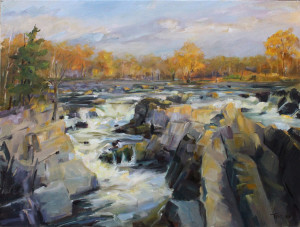 I was asked to write something about this topic, so I’ve done some research and it appears that as early as the 17th century plein air painting was a means of producing larger studio pieces. The Romantics used it in the 18th century and the Barbizon painters, including Rousseau, Millet and Corot, went outside to do sketches that helped them in their studio works. The Hudson River painters used their plein air painting to record landscapes both to the north and to the west and created hugh canvases that were presented to audiences back east, impressing them with rarely seen landscapes. For most of this time the camera was not an option so getting outside and making reference sketches was a perfect means to an end. By the mid 19th century all that changed as did the idea of making finished works on location. The new tubed paints and field easel spurred on Impressionism. Claude Monet, Alfred Sisley, Pierre-Auguste Renoir and Frederic Bazille, discussed wanting to capture the light at a specific moment in time. Out of this philosophy came Monet’s wonderful series of Haystacks and the Rouen Cathedral paintings.
I was asked to write something about this topic, so I’ve done some research and it appears that as early as the 17th century plein air painting was a means of producing larger studio pieces. The Romantics used it in the 18th century and the Barbizon painters, including Rousseau, Millet and Corot, went outside to do sketches that helped them in their studio works. The Hudson River painters used their plein air painting to record landscapes both to the north and to the west and created hugh canvases that were presented to audiences back east, impressing them with rarely seen landscapes. For most of this time the camera was not an option so getting outside and making reference sketches was a perfect means to an end. By the mid 19th century all that changed as did the idea of making finished works on location. The new tubed paints and field easel spurred on Impressionism. Claude Monet, Alfred Sisley, Pierre-Auguste Renoir and Frederic Bazille, discussed wanting to capture the light at a specific moment in time. Out of this philosophy came Monet’s wonderful series of Haystacks and the Rouen Cathedral paintings.
For me, I love painting outside. I enjoy the challenge of capturing everything I am experiencing at the moment. I do use some of my plein air paintings as reference for other works, but more often than not it is the memory of the experience that translates to the studio painting. My on site paintings have more energy overall. And if I should bring them back to the studio to finish, I try to maintain the energy and feeling of the original experience. If I were to then want to do a new studio painting I would have to change many elements to keep the painting fresh. Donald Demers, one of the great seascape painters of our time, said, and I hope I am getting this right, that when you work out all the problems on a sketch, the studio painting can suffer in its freshness. He suggests doing the sketch in a different medium, so that the new painting presents you with new challenges.
As a painter in these times, we are both blessed and cursed with the ultimate freedom to create. We are not constricted as were previous generations. But with that freedom, as I’ve explained in previous blogs, comes the minimization of training, the feeling that we don’t need to know our craft. At the same time though, comes a freedom of expression to create wildly original works of art. I think as with everything in life, put the time in, be true to yourself, then love what you do.


What an awesome post Joe! Although I have only tried painting outside once years ago at a week long oil painting class in Maine, I enjoyed being outside painting as well.
Your work certainly shows not only do you know your craft well but that you have dedicated your time to producing such BEAUTIFUl art.
Thank you for sharing your thoughts and talent with so many.
Thank you Carolyn for the kind words.